The iPhone 6 Camera Has a Big Problem: iOS 8
The iPhone 6 hangs it hat on a new and improved camera, but our tests reveal serious image-quality problems and iOS 8 looks to be at fault.
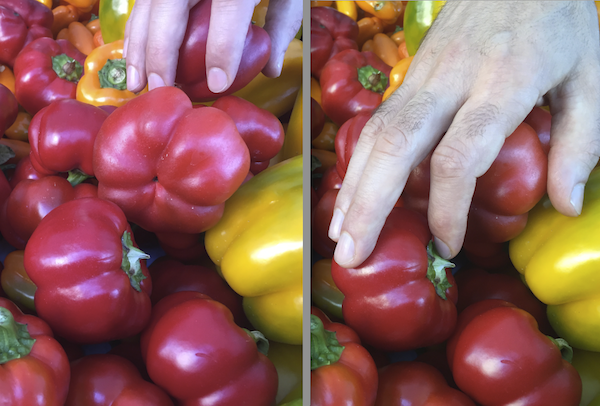
Since the iPhone 4, Apple has taken a leadership role in developing innovative phone cameras. The iPhone 6 and 6 Plus introduce new advances for Apple, including fast "focus-pixel" autofocus and optical image stabilization (in the iPhone 6 Plus). While these features were impressive in our initial tests of both models, and most photos looked pleasing, we often saw fundamental flaws in how the cameras capture colors.
Over several days of testing with an iPhone 6 Plus and two iPhone 6 models, we observed inconsistent white balance that can turn photos slightly purple or magenta, as well as an effect known as chromatic aberration that puts a purple smear on the edge of pictures. We shot identical test photos with iPhone 5 and 5s models, some running iOS 7.1.2 and some running iOS 8.0. The results lead us to suspect that the problems may be software-related, as they were absent or less severe in photos from phones running iOS 7.
MORE: iPhone 6 Camera Quirks – and How to Fix Them
We also took comparison photos with a Galaxy S5 running Android 4.4.2, and didn't see the color problems that cropped up in several of the iPhone images. (We assessed test images on three professional, calibrated LCD monitors and two MacBook Pros with retina displays.) Furthermore, some of the color problems are evident (but not called out) in photos and video from reviews by other tech sites.
We have shared our test photos and videos with Apple, which is investigating the issues we discovered. Because these problems occurred with three iPhone 6 models (plus several more in the other reviews), we are confident that the image-quality glitches are not an isolated fluke. We expect to learn more as Apple continues to analyze the results, but here's what we know so far.
Photos turning pink and purple
Shooting vegetables at a farmers' market in Manhattan's Union Square, we noticed that red peppers appeared purplish in photos from the iPhone 6 and 6 Plus. The effect was far more dramatic when we photographed the hand of one of our testers reaching for an apple from a shaded bin. In the iPhone 6 Plus photo (below left), his hand turns a purplish pink. The same photo taken with a Galaxy S5 (at right) appeared much more natural. These results happened in a shaded but bright farmer's stall — under lighting conditions that photographers call "open shade," which should be ideal for picture taking.
Click the images for larger versions.
Sign up to get the BEST of Tom's Guide direct to your inbox.
Get instant access to breaking news, the hottest reviews, great deals and helpful tips.
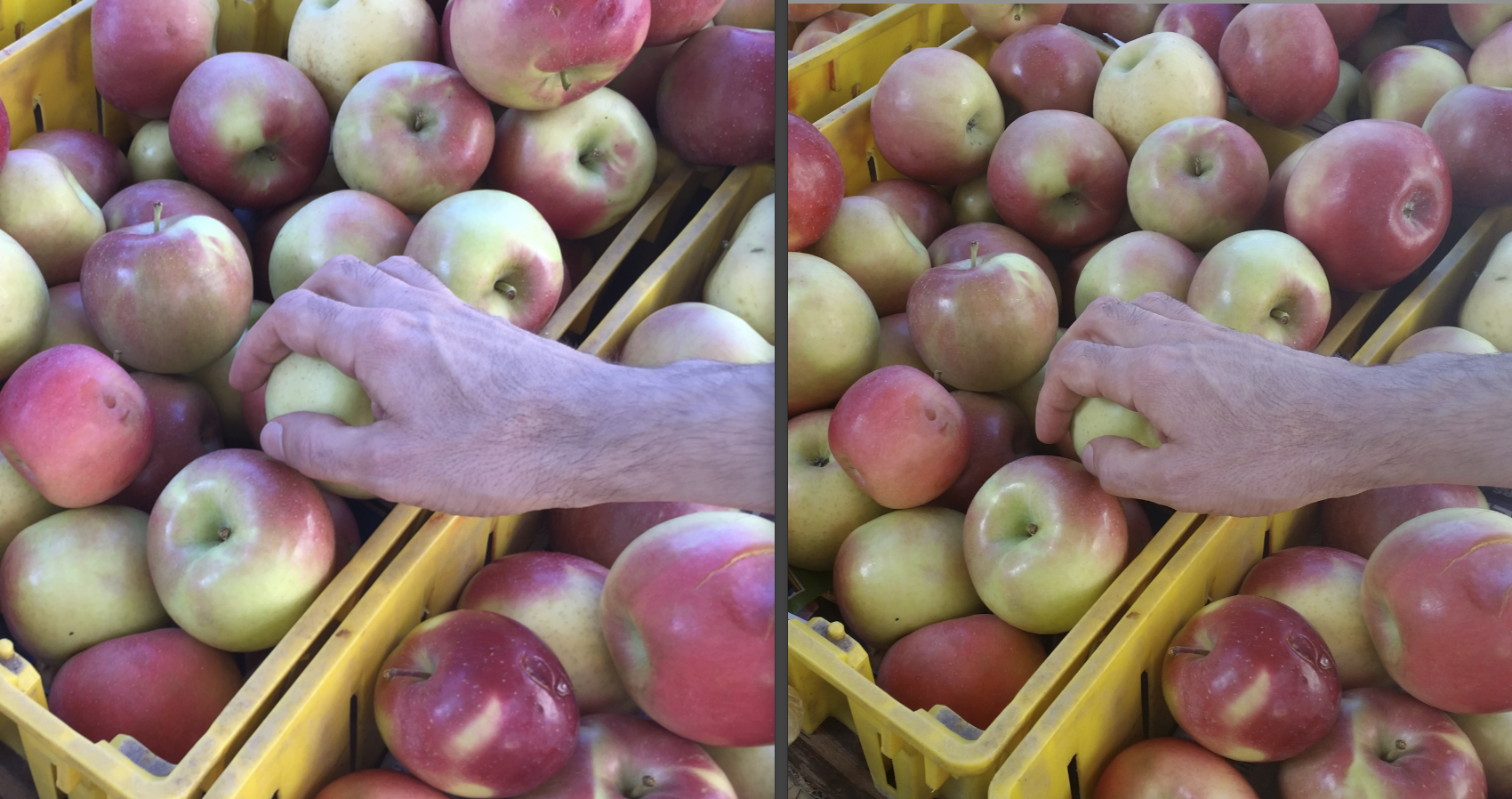
The color problem is likely in the iPhone's white-balance algorithms. As in other cameras, the automatic white-balance function is meant to neutralize any color cast in a scene to make whites look white and everything else appear natural. But the iPhones running iOS 8 were unable to hold a consistent white balance as items in the scene changed. You can see that below in two photos taken with an iPhone 6 Plus. Notice how moving a hand further into the frame changes the overall color.
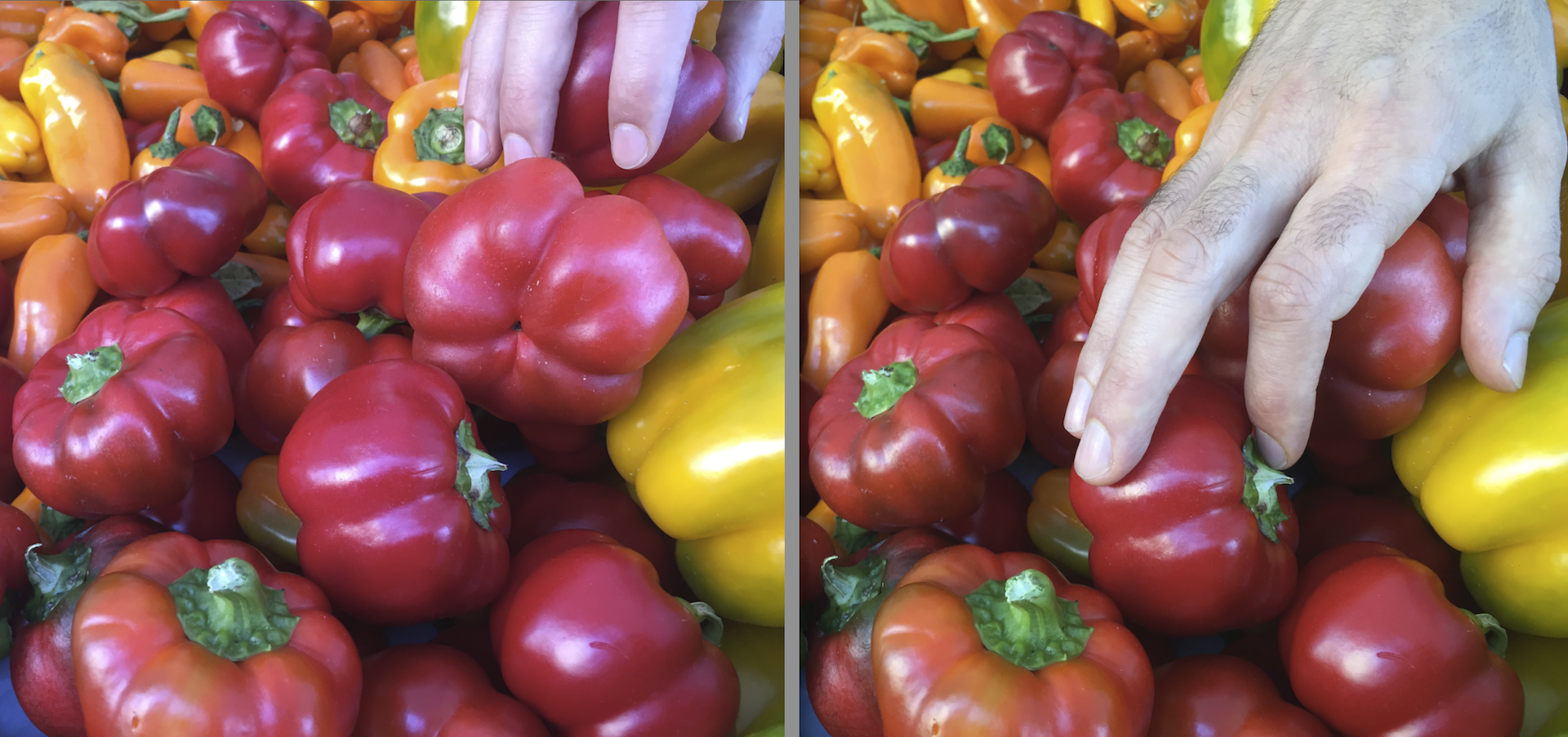
You can see the shift happening in real time in this video below, shot with the same iPhone 6 Plus. The peppers turn from purple to a more natural red when a hand comes into the frame, and hand turns from pink to a natural-looking flesh tone.
In reviewing some of our test photos, Apple representatives said that the colors may have shifted as the result of changing content in different photos. But that's not how white balance works. It takes account of the color of light falling on the subjects, not on the assortment of subjects in a photo. Regardless of what else is happening in the shot, red peppers should never look purple, and white hands shouldn't turn pink.
MORE: Camera Face-Off: iPhone 5s vs. Galaxy S5
Colors shifted like this in many other situations, such as this scene in the park with and without two of us in the foreground. When we stood in front of the camera, the entire scene took on a bluish-green appearance — evident in the exaggerated blue of the shirts and the cyan (light green) tint to the white tents in the background. When we moved out of the frame, the whole scene's coloring shifted to an even bluer shade, as you can see from the color of the pavement. The sky also turns bluer, but that's at least partially the result of the dramatic change in exposure. The iPhone 6 and 6 Plus have face detection, so when we are in the scene, it sets the entire exposure brighter to show our faces brightly.
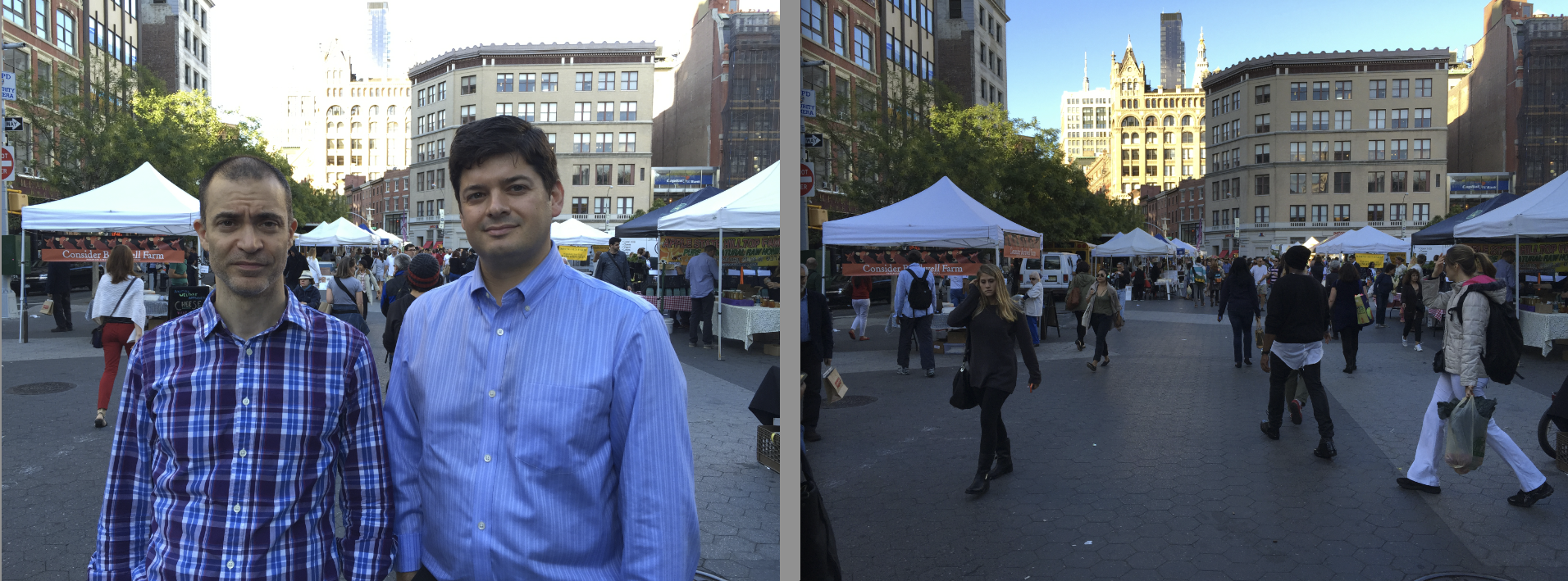
We saw similar problems in photos and videos from an iPhone 5 and 5s that were running the new iOS 8 operating system. But we did not see the color issues with an iPhone 5 and 5s running iOS 7, which leads us to believe that Apple may be able to fix the color problem by issuing an update to iOS 8.
The color shifts did not happen in the same photo of us in the park taken with the Galaxy S5, below. The change in exposure is also subtler. This could be because the Galaxy S5 defaults to center-weighted light metering, which optimizes exposure for the center portion of the frame, regardless of what's in it.

It's important to note that we didn't see the color problem under all lighting conditions, for example, in this photograph of a co-worker both indoors and outdoors in late afternoon. Her skin appears unnaturally pinkish indoors, while in the outdoor shot, it has a slight warm tone. (The latter is in line with what we've seen from the iPhone 5 and 5s in the past, running iOS 7.) These two photos were taken with an iPhone 6, but we got identical results shooting the pictures simultaneously with an iPhone 5s that was running iOS 8.
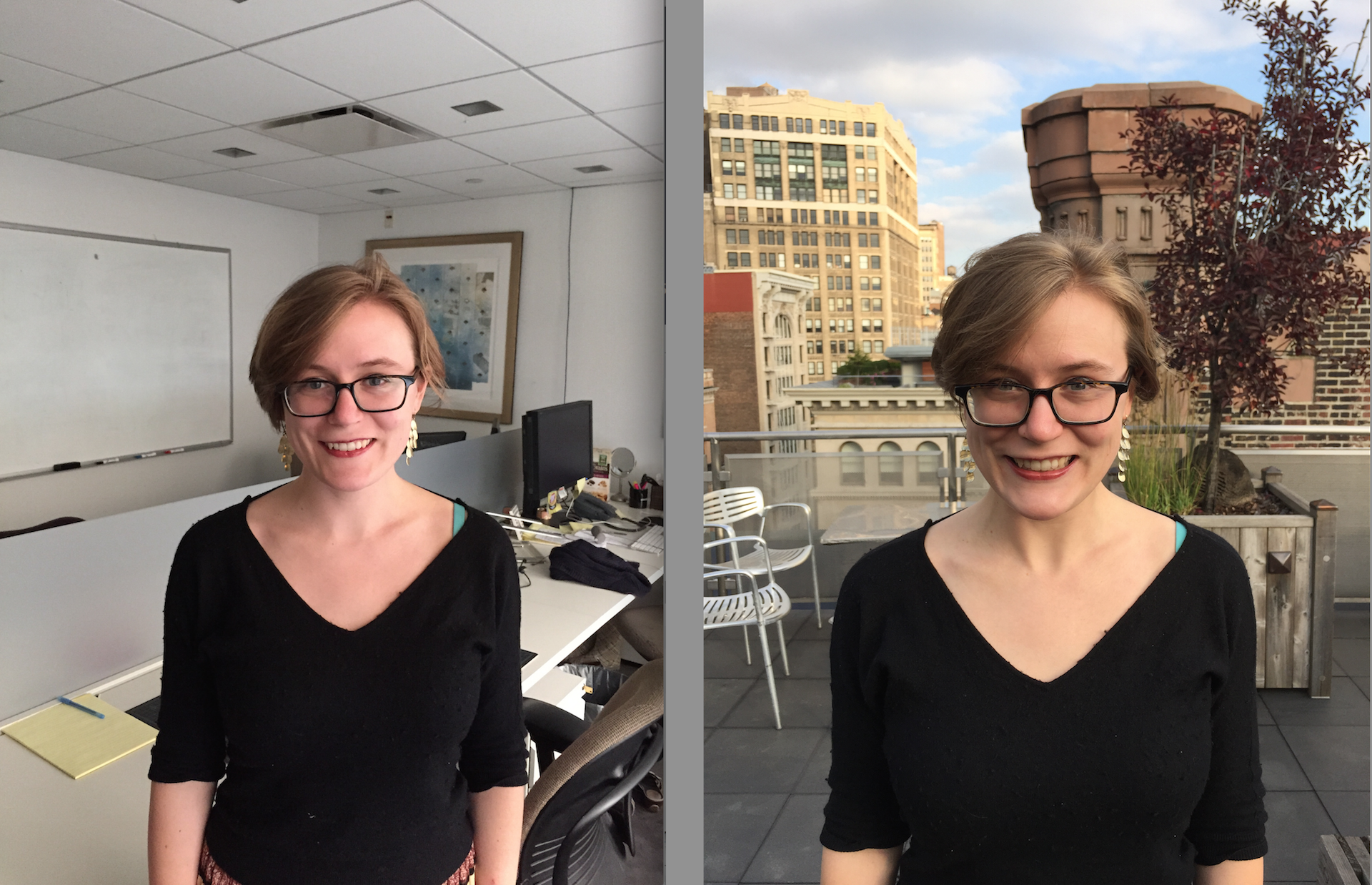
Another reviewer's samples
A lot of attention has gone to a review by travel photographer Austin Mann, in cooperation with technology news site The Verge, in which he shot extensively with the iPhone 6, 6 Plus and 5s in Iceland. His photos are attractive, but most have been edited in one or more programs (which he states clearly on his site). Mann and his team also shot an extensive video about the photo trip, using an iPhone 6 and 6 Plus. Mann does not mention editing the video to adjust image quality.
In the film, the magenta (pinkish) cast is stark under low-light conditions, which jibes with our still photo and video findings. Please see the embedded video from Mann's YouTube channel below — especially the skin tones at the following points in the footage: 1:00; 2:52; 3:10; 3:30; and 3:47.
Purple Fringing in iOS 8 Photos
Back to our tests, we also noticed occasional cases of chromatic aberration, in which a harsh contrast between light and dark produces a colored haze — often a purple one. In our experience testing many cameras, a bright light at the edge of the frame, in dark settings, sometimes creates a purple fringe with some cameras and lenses.
MORE: iPhone 6 Benchmarks: Here's How Good It Really Is
That's exactly what happened in several photos, including in a dark New York subway station with scattered bright lights. It also happened when we photographed the produce section in a gourmet market. A bright light running the length of the shelf above produced varying degrees of purple fringing — from a tad in the upper-left corner to a stripe across the entire top of the picture. In each case, we held the camera in several positions in order to maximize the fringing effect and see how bad it could get. Consequently, the composition of the photos varies a bit.
The iPhone 5 photos fared worse, regardless of whether the cameras were running iOS 7 or 8. The iPhone 5s running iOS 7 never produced a purple fringe, although there was a slight hazy look at the top of the photo. Purple fringing returns with the iPhone 5s running iOS 8, though it's restricted to a small spot in the corner. This suggests that the 5s camera produces less fringe than the iPhone 5 camera, and that iOS 7 helps eliminate the little that does appear. (It's common for modern cameras to clean up flaws like chromatic aberration or lens distortion.) The fact that the purple haze returns in an iPhone 5s with iOS 8 may mean the new operating system is less adept at cleaning up the flaw.
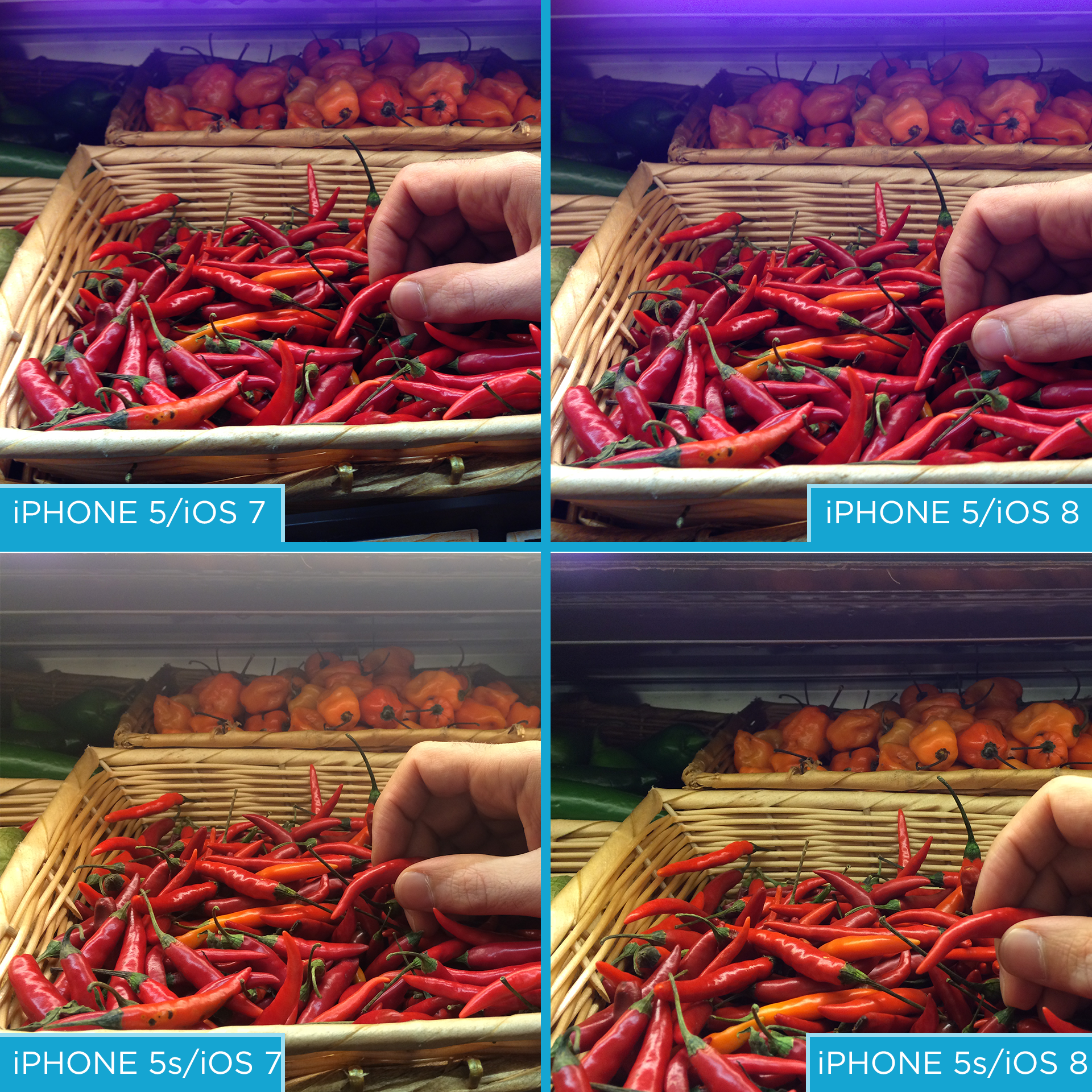
Photos from the iPhone 6 seem to back that up. The purple fringe is equally as small as it is on the iPhone 5s photos. And both cameras are running iOS 8. As with the faulty white balance, it's possible that a software upgrade could also fix the chromatic aberration.

We saw no chromatic aberration in any of several dozen Galaxy S5 photos shot in the same settings as the iPhone photos that do show it. (Composition is slightly different due to the camera's wider aspect ratio, but again, our main goal was to maximize the chance of chromatic aberration.)

It may be that Android 4.2 is better at removing the artifact, or that the design of the camera prevents it. The iPhone 5 and 5s cameras are flush with the back of the phone, while the iPhone 6 and 6 Plus cameras protrude slightly. The Galaxy S5 camera, in comparison, is slightly recessed. This might block light from hitting the lens from the side, which is often a cause of chromatic aberration.
We still can't say definitively what is causing these image-quality problems. Nor do we know if the problems can be fixed. We expect to know more as Apple continues to investigate, and we'll keep you in the loop.
- iOS 8 Manual Camera Controls: Don't Bother — Yet
- How to Take Better Photos with Your iPhone
- Best Smartphone Camera 2014
Contact senior editor Sean Captain at scaptain@tomsguide.com if you are having an iPhone 6 problems, or for any other scoops. And follow me @seancaptain and on flicker at Sergiocapitano. Senior photographer Jeremy Lips and senior editor Mike Prospero contributed extensively to this article. Follow us @tomsguide, on Facebook and on Google+.
Sean Captain is a freelance technology and science writer, editor and photographer. At Tom's Guide, he has reviewed cameras, including most of Sony's Alpha A6000-series mirrorless cameras, as well as other photography-related content. He has also written for Fast Company, The New York Times, The Wall Street Journal, and Wired.
-
house70 Great. Now we have bendgate and cameragate, so to speak. Not to mention batterygate (always a given with iphones) and the good old antennagate.Reply
Someone said that Apple is waiting for trends to "settle" in the general community before jumping in, that's why they waited a few years to increase the screen size. However, they should have not used the same beer-can aluminum on them and taken a clue from phablet manufacturers a while ago. -
amk-aka-Phantom ReplyBatterygate?..lol I've always made it a full day on every iphone I've ever had. I don't have to cripple my device like you do with Android to make it last all day. Samsung releases a watch...flops badly...Apple releases a better watch which will they will sell millions. You wonder why Samsung profits are down 25% the last quarter...
I have an old-ass Samsung Galaxy S1 running Android 4.4.4 and I charge it once in 2-3 days. Never changed the battery. Say what about crippling?
Also, Samsung's watch can call, unlike Apple's. I don't care that people will mindlessly buy Apple's watch because it "sets a trend" or whatever it is the Verge and other BS news sites want you to believe, Samsung released a more functional piece of hardware. Nothing you say can change that. -
falchard Anyone else surprised that the article describes the camera on an iPhone good and completely ignores any Windows Phone cameras. Instead they pull up some Samsung as a comparison.Reply -
BlankInsanity the ios8 issue needs resolving but I don't think the phone is the blame but rather the software, disregarding that, the bend issue with the iphone 6. Well use some common sense, you don't buy a 5.5 inch phone, put it in the back pocket of skinny jeans and then sit on it, it will most likely bend a clear example here: http://www.cultofmac.com/297404/get-bent-shocking-history-bent-smartphones/ All I'm saying is take proper care of your phone and it won't bend but don't hassle the Iphone 6 over being cheap, you just don't know how to take care of stuff.Reply
just to say Samsung S5 user here, so don't call me a 'sheep' or anything -
fuzzion This is sad because many were hoping that the iphone 6 would be a good upgrade. I guess its the superior phone AKA Note 4 for meReply -
Tinny77 http://www.dxomark.com/Mobiles/Apple-iPhone-6-and-6-Plus-review-Bigger-and-better.-Apple-set-gold-standard-for-smartphone-image-qualityReply -
golftango "It may be that Android 4.2 is better at removing the artifact, or that the design of the camera prevents it. The iPhone 5 and 5s cameras are flush with the back of the phone, while the iPhone 6 and 6 Plus cameras protrude slightly. The Galaxy S5 camera, in comparison, is slightly recessed. This might block light from hitting the lens from the side, which is often a cause of chromatic aberration."Reply
Could you have just put the phone in a case which recessed the lens to test this hypothesis? -
Alan Pritchard Not sure it matters, all pics taken on an iphone will be put through instagram filters anyhow......Reply -
johnsaxon Hi- I've been a pro photographer for 35 years and would like to comment on the white balance issue. You will usually get better results using a fixed white balance like the "daylight" or "tungsten" setting. Auto balance is an imperfect solution that makes an educated guess based on the content of the photo. If there is no white or grey reference in the scene the camera has no way of knowing how to balance the color so you will get all kinds of strange results. So in the shot with the bell peppers the camera has no idea how to balance the shot and probably just sets itself roughly to daylight as a best guess. There is no magic to color balancing. For the best result you can shoot a reference photo of a neutral grey card and then keep that color balance (assuming that your camera has that capability). If the iPhone has the ability to set the color balance for "daylight" etc. I would do that rather than rely on auto balance.Reply
